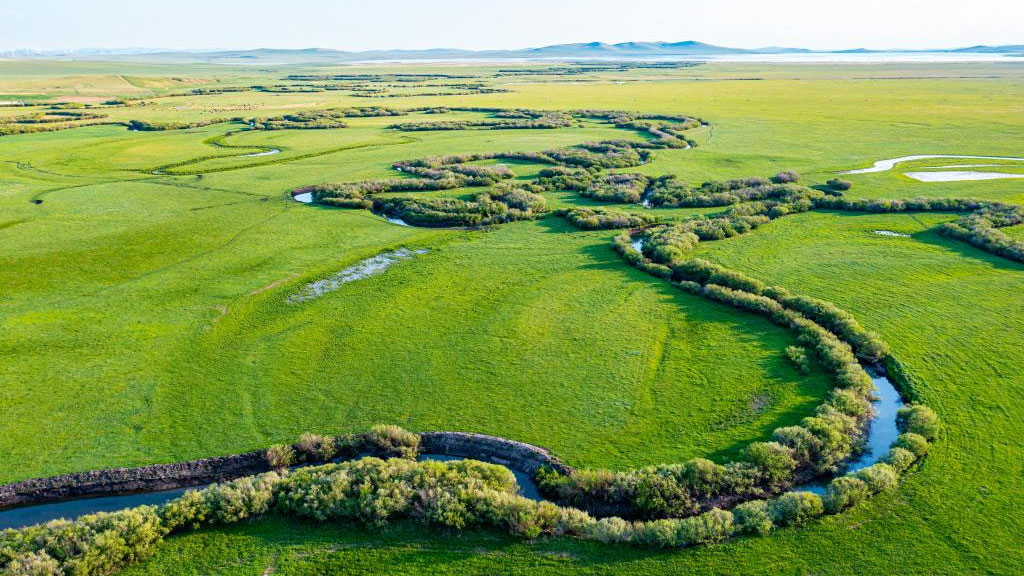Scientific advancement transforms China's saline-alkali land
CHANGCHUN, June 16 (Xinhua) -- Although 39-year-old Ma Wei is not a physician, he has earned the nickname "Dr. Ma" among locals due to his remarkable ability to transform barren land into fertile soil.
Ma's typical day starts in the wee hours of the morning, as he rushes to a paddy field in Zhenlai County of northeast China's Jilin Province. There, he records data and checks the growth of nearly 100 saline-alkali tolerant crop varieties that he and his colleagues have carefully selected and cultivated.
Years ago, the field was nothing but a vast expanse of barren land, covered with a layer of white salt crust on the soil surface.
Soil salinization is an important cause of desertification, known as the "cancer of the Earth," Ma said, adding that his responsibility is to make unproductive land "come alive again."
Farming on saline and alkaline soil is widely recognized as a formidable challenge, resulting in significantly lower crop yields. China has about 1.5 billion mu (100 million hectares) of saline-alkali land, of which around 500 million mu is available for utilization.
As China focuses on promoting agricultural modernization, regions across the country have been making great efforts to utilize saline-alkali land with innovative solutions ranging from the breeding of saline-alkali tolerant crop varieties to soil fertilizing.
BREEDING SALINE-ALKALI TOLERANT CROPS
The Jilin Academy of Agricultural Sciences has started sending experts to Zhenlai County to treat saline-alkali soils since the 1980s. As an associate researcher with the academy, Ma became involved in this endeavor nine years ago.
The academy has worked with other Chinese research institutes in recent years to screen and nurture a number of salt-tolerant crop varieties, including five corn, nine rice and 14 soybean varieties.
As a result of these innovative efforts, annual grain production in Jilin exceeded 40 billion kg in 2021 and 2022. Thanks to high-quality seeds, the rice yield in Zhenlai County has ranked first in Jilin Province for six consecutive years.
"Seeds are the 'chips' of agriculture, and we have made many breakthroughs in this sector," Ma said.
Similar progresses have been made in China's Yellow River Delta, where over 80 percent of the land is classified as salinized and alkalinized.
In the Agricultural High-tech Industrial Demonstration Area of the Yellow River Delta, wheat crops labeled "Jimai60" registered a record yield of 460.98 kg per mu on average in the summer harvest of 2022, in a field with high salinity and alkalinity.
The achievement came owing to both technical breakthroughs in seed breeding and the utilization of saline-alkali tolerant germplasm resources. Several research institutes have collected and stored a total of 21,000 germplasm resources with such properties in the demonstration area.
FERTILIZING THE LAND
The west of Jilin Province is home to one of the world's three largest soda saline-alkali-soil areas. In Gaojia Village of Taishan Township in the city of Da'an, villagers made repeated attempts to plant rice in the past but invariably failed due to saline-alkali soil.
Things began to change after Jilin Longteng Bio-fertilizer Co., Ltd. started introducing agricultural technologies there to improve soil fertility, including applying rotary tillage and organic fertilizers.
"The use of organic fertilizers and other soil fertility boosting agents will help reduce salinity and alkalinity of the soil while raising the content of organic matter," said Li Fuqiang, head of the company, who laid out a plan for the company to transform 5,000-plus mu of saline-alkali fields surrounding the village into rice paddies.
The company is not alone in this endeavor. Over the years, a few research institutes as well as other enterprises have dedicated themselves to the control of saline-alkali fields in the west of Jilin Province. In nearly 10 years, the region has been able to expand its arable land by 466,200 mu by transforming saline-alkali fields as well as other types of low-yield land.
Merely improving and cultivating an additional 1 percent of the world's total saline-alkali land could increase grain output by 50 million tonnes, which is enough to satisfy the annual grain needs of 120 million people, according to Wang Mingming, an associate researcher with the Northeast Institute of Geography and Agroecology under the Chinese Academy of Sciences.
Empowerment through science and technology has been key to China's miracle in reclaiming and managing saline-alkali land, Wang said, adding that China's experience can provide valuable insights for other countries.
Photos
Related Stories
- Commentary: Sci-tech advancement to benefit Chinese people, whole world
- China tops natural-science research ranking
- China's mobile science popularization projects serve over 500 million people
- Chinese vice premier stresses science popularization
- China's ministry releases top 10 scientific advances
- Experts: Reform to help boost sci-tech self-reliance
- Retired teachers honored in annual Touching China award for science popularization videos
- China pursues self-reliant sci-tech progress to benefit all
- Both table, wine grapes appear 11,000 yrs ago: study
- Sci-tech opening-up, cooperation pushed
Copyright © 2023 People's Daily Online. All Rights Reserved.









